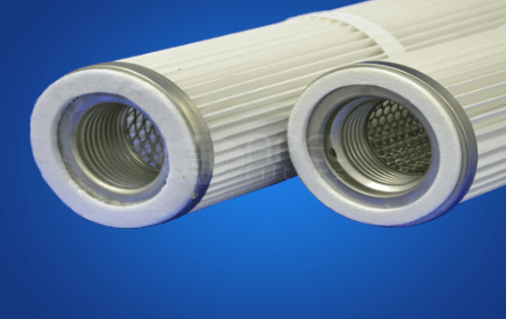Filter Bag and its working and advantages
Filter Bag are used in a in pneumatic conveying systems handling fine or dusty material, the method of filtration that has become almost universally adopted is a bag type fabric filter. These filters are commonly called bag houses. Most bag houses use long, cylindrical bags (or tubes) made of woven or felted fabric as a filter medium.
Dust laden gas or air enters the Filter Bag through hoppers by suction (normally) or positive pressure and is directed into the bag house compartment. The heavier dust particles fall off at the entry itself, while the lighter dust particles along with gas get carried upward to the bags. The gas is drawn through the bags, either on the inside or the outside depending on cleaning method, and dust accumulates on the filter media which increases the resistance to gas flow. Due to this, the filter must be cleaned periodically when sufficient pressure drop occurs.
During cleaning, dust that has accumulated on the bags is removed from the fabric surface and deposited in the hopper for subsequent disposal. Depending on the type/construction of baghouse, cleaning can be carried out while the Filter Bag is on-line (filtering) or is off-line (in isolation). If gas enters into the baghouse tangentially at the bottom of the casing, it gives the dust laden gas a circular motion which helps in removing the heavy and coarser particles that are present in the gas stream in a manner similar to a cyclonic collector. These collected particles are directly discharged into the hopper. It is only the very fine particles that get carried to and collected by the bags. Thus, the total dust load on bags is reduced.
Filter Bag are very efficient particulate collectors. They collect particles with sizes ranging from submicron to several hundred microns in diameter at efficiency of 99 percent or better. The layer of dust, called dust cake or cake, collected on the fabric is primarily responsible for such high efficiency. The cake is a barrier with tortuous pores that trap particles as they travel through the cake. Typically, inlet concentrations of pollutant to baghouses are 1 to 23 grams per cubic meter (g/m3 ) [0.5 to 10 grains per cubic foot (gr/ft3 )], but in extreme cases, inlet conditions may vary between 0.1 to more than 230 g/m3 (0.05 to more than 100 gr/ft3 ).
Standard fabric filters can be used in pressure or vacuum service, but only within the range of about ± 640 millimeters of water column (25 inches of water column). Well-designed and operated baghouses have been shown to be capable of reducing overall particulate emissions to less than 0.05 g/m3 (0.020 gr/ft3 ), and in a number of cases, to as low as 0.002 to 0.011 g/m3 (0.001 to 0.005 gr/ft3 ).
The pressure drop, called differential pressure (ΔP) between the clean gas side and the dirty gas side of the baghouse is one of the most important variables that must be considered in Filter Bag design. Pressure drop through a baghouse is caused due to the air flow’s resistance when air passes through the filtering bag and the filter cake. Typically, the pressure drop is expressed in inches or centimeters of water. This parameter is important because higher pressure drop means higher energy cost. The energy generally will be consumed by the fans that are used to push or pull the air stream through the baghouse. The differential pressure is measured by a differential pressure gage or manometer. However, over time the pressure sensing lines can become clogged with dust or damaged by moisture or corrosion, and the gauge can become unreadable. Hence, provision for cleaning the pressure taps is required to prevent premature instrument failure due to clogging.
A sudden drop in the differential pressure denotes a leak in the system. Whereas a sudden or sharp rise in the differential pressure denotes that the filter bags are becoming blinded or “caked” with particulate. Hence the differential pressure gauge is the best indicator of baghouse’s current operating status, and offers critical information for troubleshooting.
Advantages and Disadvantages of Fabric Filters
Filter Bag in general provide high collection efficiencies on both coarse and fine (submicron) particulates. They are relatively insensitive to fluctuations in gas stream conditions. Operation is relatively simple. Unlike electrostatic precipitators, fabric filter systems do not require the use of high voltage, therefore, maintenance is simplified and flammable dust may be collected with proper care. Fabric filters are useful for collecting particles with resistivities either too low or too high for collection with electrostatic precipitators. Fabric filters therefore may be good candidates for collecting fly ash from low sulfur coals or fly ash containing high unburned carbon levels, which respectively have high and low resistivities, and thus are relatively difficult to collect with electrostatic precipitators.
However, there are gas temperature limits to the application of Filter Bag because of the limits of the fabric itself. At high temperatures, the fabric can thermally degrade, or the protective finishes can volatilize. Accordingly, fabric filters have usually been limited to gas temperatures below approximately 260°C (500°F), which is the maximum long-term temperature of the most temperature-tolerant fabric. Fabrics can burn if readily oxidizable dust is being collected. Fabric filters have relatively high maintenance requirements (e.g., periodic bag replacement). Fabric life may be shortened at elevated temperatures and in the presence of acid or alkaline particulate or gas constituents. They cannot be operated in moist environments; hygroscopic materials, condensation of moisture, or tarry adhesive components may cause crusty caking or plugging of the fabric or require special additives. Respiratory protection for maintenance personnel may be required when replacing fabric. Medium pressure drop is required, typically in the range of 100 to 250 mm of water column (4 to 10 inches of water column).






